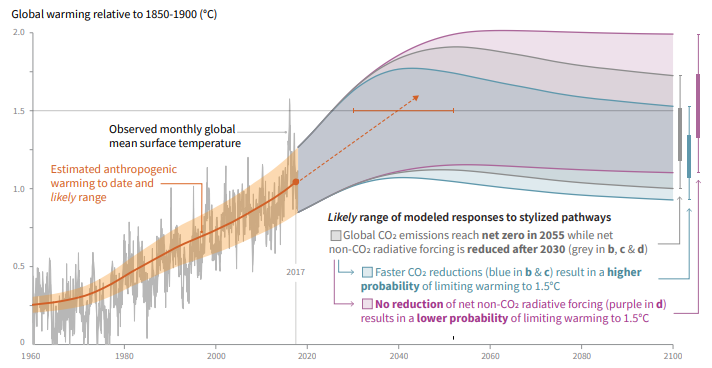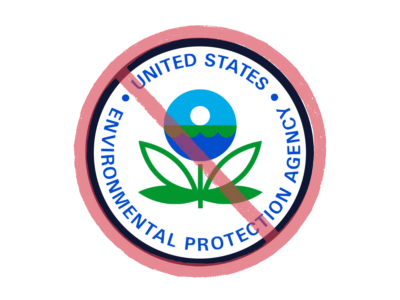The Elephant In The Atmosphere
The IPCC’s report rings alarm bells on climate change.
As many major news outlets have reported, the UN’s Intergovernmental Panel on Climate Change (“IPCC”) released a special report last Saturday detailing the harmful effects of global warming at 1.5 degrees Celsius above pre-industrial levels.
This new threshold number is significant. The Paris Agreement on climate change aims to limit global warming to 2 degrees Celsius, but at the behest of small island nations fearing the consequences of climate change-induced sea level rise, the IPCC agreed to study the impacts of climate change at a still lower temperature increase. The IPCC’s scientists concluded that the Paris commitments aren’t enough.
The IPCC report projects warming in excess of 1.5 degrees Celsius under a number of scenarios:

Credit: UN IPCC, Oct. 6, 2018
The results of the report are clear: the catastrophic effects of climate change are already upon us, and we are out of time to prevent some very significant harms. Holding the temperature increase to 1.5 degrees Celsius will take serious effort—at the rate we’re going, we could blow past a 1.5-degree increase within the next fifteen years—but the IPCC predicts that the ill effects from a temperature increase between 1.5 and 2 degrees Celsius would be substantially worse. One UN official called the report “a deafening, piercing smoke alarm.”
Here are a few key takeaways from the report:
- Humans are causing global warming. This isn’t a new assertion, but the IPCC report is clear on this point: not only have human activities resulted in substantial global warming, but they are on course to nearly double the amount of warming in the next three decades. Human activities have caused about 1 degree Celsius of global warming above pre-industrial levels, and the IPCC projects, with high confidence, that global warming will reach between 1.5 and 2 degrees Celsius between 2030 and 2052 if the current trend persists. Some regions suffer more than others; for example, the Arctic is already experiencing warming greater than the global annual average.
- While it would take multiple decades, reaching and sustaining net zero anthropogenic CO2 emissions would halt global warming. Net negative emissions may be needed to reverse ocean acidification and minimize sea level rise. In other words, serious harms from climate change are now inevitable, but our efforts to reach net zero matter—things could be much worse if we don’t try. We still have a chance to limit warming and stop further temperature increases in the coming decades.
- Changes from global warming are already happening. The IPCC’s scientists found, with high confidence, that we have already observed impacts to natural and human systems from global warming, and that many land and ocean ecosystems have already changed as a result. While adaptation and mitigation are already happening, much more is needed, quickly, to reduce future climate change-related risks.
- There’s a big difference between 1.5 degrees Celsius and 2 degrees Celsius. If we were to stick to the Paris Agreement’s target, we could expect even greater temperature extremes, higher risks from drought and heavy precipitation events like tropical cyclones, and more significant sea level rise. Even if we hold temperature increases to 1.5 degrees, sea level rise will continue beyond 2100, but if temperatures exceed 1.5 degrees, multi-meter sea level rise could be triggered by irreversible losses to Greenland’s ice sheet and marine ice sheet instability in Antarctica. And if we wait until we’ve exceeded the 1.5-degree threshold to get serious, we expose ourselves to more, and worse, risk than if we act now to keep warming below that target level.
The clearest takeaway is that the United States’ do-nothing approach will land us squarely in the path of serious climate harms, and fast. As it rolls back Obama-era policies combating climate change and seeks to curtail the efforts of states trying to do better than the federal government, the Trump Administration is fond of taking the position that none of this really matters: climate change is coming anyway, so we may as well accept the inevitable and let emissions continue under-regulated. In a more egregious example, Trump’s EPA has argued that the potential for serious global warming by 2100 means clean car standards are irrelevant; it has applied that same logic to argue that California doesn’t need a waiver for its Advanced Clean Cars program, which is designed to tackle mobile source greenhouse gas emissions.
The IPCC report underscores just how wrongheaded that thinking is. While some harms from climate change are inevitable, the IPCC’s assessment shows that quick action to reduce emissions can spare us the worst of what a climate change-impacted future has to offer. And the report addresses this thumb-twiddling attitude head-on, explaining that if we wait for the worst to occur and then attempt to work backwards, letting global temperature increases exceed 1.5 degrees Celsius and then attempting to claw our way back, we will suffer “long-lasting” and “irreversible” impacts, including the loss of ecosystems.
The fire alarm’s ringing; this isn’t the time to put climate change policies on the back-burner.
Reader Comments
2 Replies to “The Elephant In The Atmosphere”
Comments are closed.







Julia said;
“….While it would take multiple decades, reaching and sustaining net zero anthropogenic CO2 emissions would halt global warming…..”
Dear Julia,
There is no scientific proof that “net zero anthropogenic CO2 emissions” would actually halt global warming in fact. Water vapor and solar radiation have vastly greater effects on climate than an insignificant trace gas CO2.
As you know, there are major uncertainties and much erroneous information regarding the relatively minor role of CO2 in global warming. That is why vain empty rhetoric about “net zero anthropogenic CO2 emissions” is not supported and backed-up with guarantees, warranties, performance standards, measurements, verification and firm commitments.
Sorry Julia, you don’t know how to halt global warming and neither does anyone else.
There are many methods to remove carbon dioxide from the atmosphere ranging from agressive physical processes to biological processes such as reforestation and even restoration of sea otters and hence kelp forests.
Just marine processes could sequester a substantial amount of carbon, perhaps as much as half what would be required (the deep ocean currently stores 100 times what is in the atmosphere).